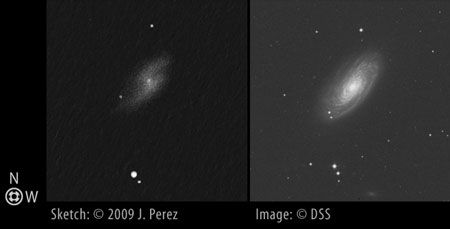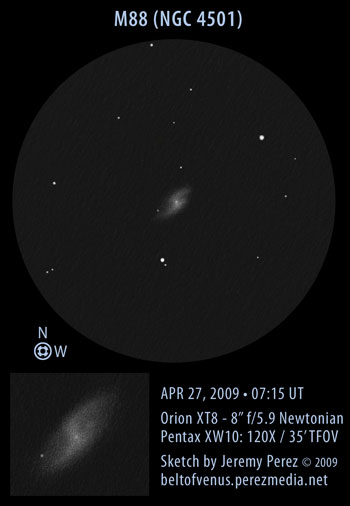Observation Notes:
During the first few minutes of my observation, M88 appeared to be simply an elongated galaxy with a strongly condensed core aligned at about 135 degrees. After much time glued to the eyepiece, the northwest and southern edges took a slightly brighter appearance. A short north-south axis appeared between these brighter regions, suggesting a clockwise spiral form. A star marked the southeastern tip and a bold double star anchored the view about 6 arc minutes to the south.

Sketch/DSS Photo Comparison of Messier 88 (NGC 4501)
Object Information:
M88 lies about 60 million light years distant, is estimated to be 130,000 light years in diameter and is receding at 2000 km/second. It was discovered by Charles Messier in 1781, and is also cataloged as NGC 4501, UGC 7675, MCG+03-32-059, h 1312, GC 3049, CGCG 099.076, VCC 1401, PGC 41517.
| Subject | M88 (NGC 4501) |
| Classification | Spiral Galaxy (Sb/Sc I) |
| Position* | Coma Berenices [RA: 12:31:59.1 / Dec: +14:25:15] |
| Size* | 6.9′ x 3.7′ – PA: 140° |
| Brightness* | 9.7 vMag; 10.3 bMag; 13.1 Surface Brightness |
| Date/Time | APR 27, 2009 – 12:15 AM (APR 27, 2009 – 07:15 UT) |
| Observing Loc. | Flagstaff, Arizona – Home |
| Instrument | Orion SkyQuest XT8 Dobsonian (203 mm dia./1200 mm F/L) |
| Eyepieces/Mag. | Pentax XW10 (120X) |
| Conditions | Clear, calm, porch lights |
| Seeing | 5/10 |
| Transparency | Mag 5.8 NELM |
| *Sources | SEDS; NGC/IC Project; DSS; Starry Night Pro Plus 5; Atlas of the Messier Objects – Ronald Stoyan |
